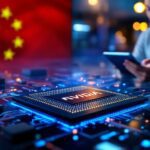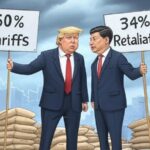While China’s public criticism of semiconductor export controls might appear as mere diplomatic posturing, the timing and intensity of these complaints reveal a sophisticated strategic calculation that extends far beyond standard trade disputes. China has recently escalated its rhetoric against the Trump administration’s stringent semiconductor export controls, which have been systematically expanded since October 2022 under the Biden administration and further intensified in March 2025. These restrictions specifically target China’s access to advanced semiconductor technology, fundamentally disrupting the nation’s ability to develop high-end computing capabilities. The strategic depth behind China’s vocal opposition suggests this represents more than frustrated diplomacy—it’s a calculated move in a broader technological chess match.
Key Takeaways
- U.S. semiconductor export controls have created a dual impact, hindering China’s technological advancement whilst simultaneously reducing American companies’ revenue and market intelligence capabilities.
- China’s public criticism strategy aims to highlight the economic costs to U.S. firms, potentially creating domestic pressure for policy reconsideration.
- Export restrictions have accelerated China’s domestic semiconductor development efforts, potentially spurring breakthrough innovations that could challenge U.S. market dominance.
- The controls extend beyond chip access to include Western design tools and manufacturing equipment, creating comprehensive technological barriers.
- Third-country circumvention prevention measures demonstrate the global scope of U.S. enforcement efforts.
The Strategic Calculus Behind China’s Public Opposition
According to CNBC reporting, China’s characterisation of the semiconductor export controls as “abuse” reflects a carefully orchestrated response designed to exploit inherent contradictions in U.S. policy implementation.
Economic Pressure Points
The export controls have created significant economic disruption across both nations’ semiconductor ecosystems. In China, the restrictions have led to substantial price increases and workforce reductions throughout the industry. However, the reciprocal effect on U.S. companies reveals the strategic vulnerability China seeks to exploit.
American semiconductor firms face reduced revenue streams and, critically, diminished visibility into Chinese technological developments. This intelligence gap represents a strategic blindspot that China’s public criticism aims to amplify, potentially creating pressure from U.S. industry stakeholders for policy modification.
Innovation Acceleration Through Restriction
The export controls have produced an unintended consequence that China’s criticism subtly highlights: the acceleration of domestic innovation. Chinese engineers, blocked from accessing Western technology, have been compelled to develop novel chip designs independently. This forced innovation cycle potentially yields breakthrough technologies that could fundamentally challenge established U.S. dominance in the semiconductor sector.
Comprehensive Technological Containment Strategy
The U.S. approach extends beyond simple export restrictions to encompass a comprehensive technological containment framework. The strategy specifically targets:
- Advanced computing chips and related manufacturing equipment
- Western design tools essential for high-end device production
- Third-country circumvention routes through expanded license requirements
- Broader ranges of advanced computing technology categories
This multifaceted approach demonstrates the systematic nature of U.S. efforts to maintain technological superiority whilst preventing China from developing independent advanced semiconductor manufacturing capabilities.
Counter-Perspective: The Isolation Risk
Industry experts present an alternative interpretation of China’s criticism strategy, suggesting it serves to highlight genuine economic risks inherent in the U.S. approach. The export controls may inadvertently isolate American firms from global markets, creating opportunities for Chinese competitors to establish alternative supply chains and technological ecosystems.
This counter-narrative suggests that China’s public opposition serves to amplify concerns within U.S. business communities about long-term market access and competitive positioning. Historical precedents in technology sector trade restrictions demonstrate how protective measures can sometimes accelerate competitor development rather than containing it.
Practical Implications and Market Dynamics
The ongoing semiconductor export control dispute creates several immediate implications for global technology markets:
- Supply Chain Restructuring: Companies must navigate increasingly complex compliance requirements whilst maintaining operational efficiency
- Investment Reallocation: Both nations are accelerating domestic semiconductor development investments
- Technological Bifurcation: The industry faces potential division into distinct technological ecosystems
What to Watch
Critical developments to monitor include China’s progress in domestic semiconductor manufacturing capabilities, U.S. industry lobbying efforts regarding export control modifications, and third-country responses to circumvention prevention measures. The effectiveness of China’s public criticism strategy will likely be measured by any shifts in U.S. business community support for current export control policies.
The ultimate question remains whether China’s vocal opposition represents genuine frustration with trade restrictions or a calculated effort to exploit the economic contradictions inherent in technological containment strategies.
News Source: CNBC








